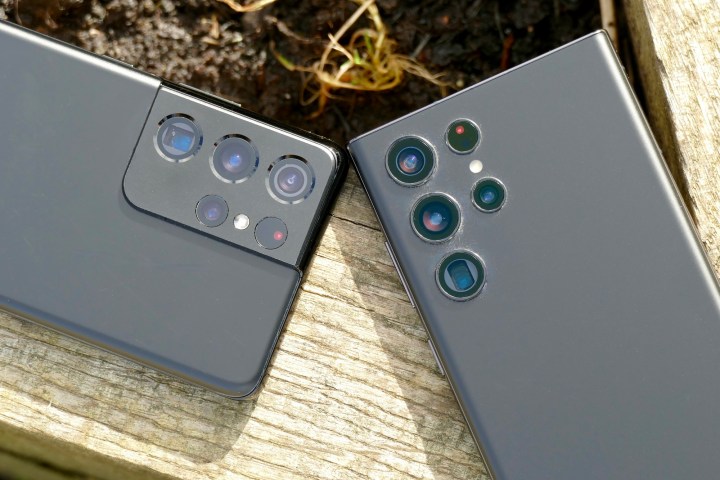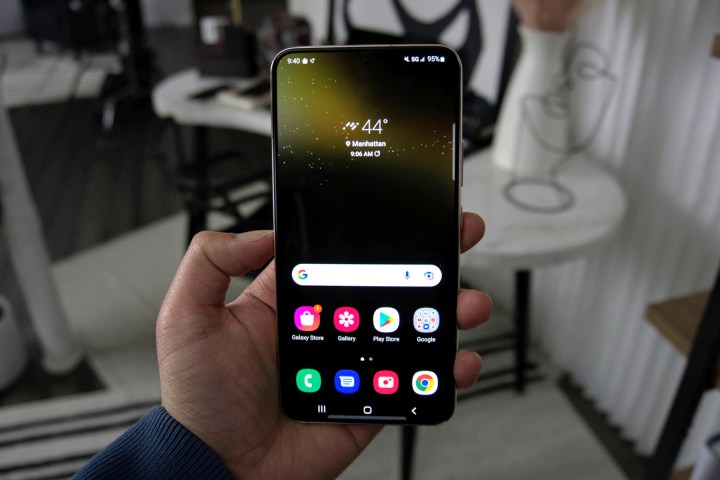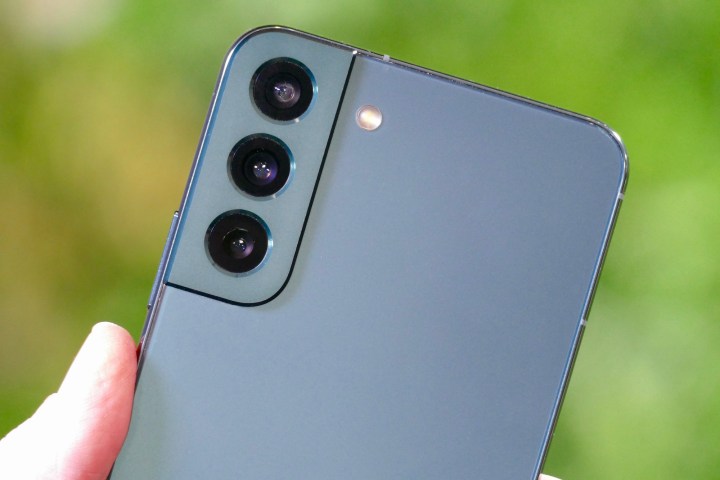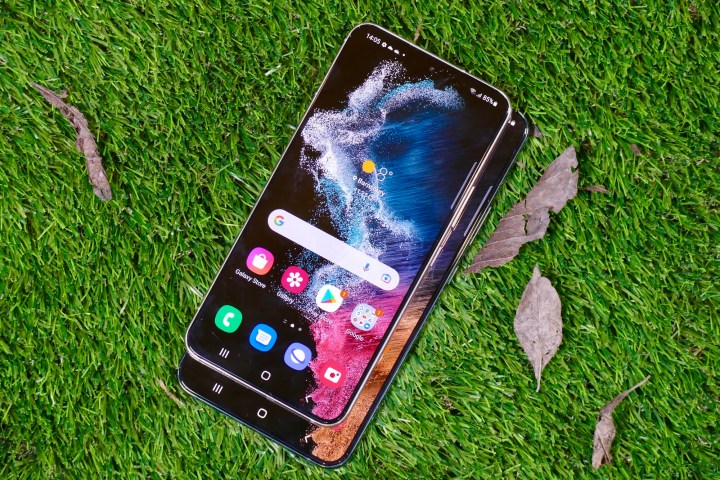Samsung’s latest generation, the S22 series, may appear on the surface to merely copy its admittedly excellent camera array from the last generation, but this is a good lesson in why it’s vital to never judge a new phone by its spec sheet.
Camera array
The first thing to note is that the S22 and S22+ share the same camera system, so going forward, I’ll be referring to them collectively as the S22. Design-wise, the S22 and S22 Ultra retain the same layout as the S21 series. However, while the S22 retains the singular camera block of the S21 into which the cameras themselves are embedded, the S22 Ultra takes a drastic new direction and ditches the larger bump for individual protruding camera lenses.

Personally, I’m not sure how I feel about this design choice, as I actually found the camera bump on the S21 Ultra to be visually attractive. On a more practical note, I can’t help but wonder if removing the larger bump might make the cameras more vulnerable to damage. Also, now when you place the S22 Ultra down on a table, it will now be balancing on the telephoto camera, rather than on the rim of the larger camera bump as it did with the S21 Ultra. All that said, it is an exciting aesthetic change that sets it apart from its predecessors.
Rear camera
The rear camera is practically identical to that of the S21 series. The S22 gets a 10MP hole-punch camera with an F2.2 aperture and 1/3.24-inch sensor size. The S22 Ultra similarly shares a hole-punch selfie camera with its predecessor, featuring a 40MP lens with an 80-degree field of view, F2.2 aperture, and 1/2.82-inch sensor. If selfies are a big deal to you, then upgrading to the S22 Ultra offers a huge advantage over the less expensive models.

Main camera
The S22 features three cameras. In addition to a 50MP wide angle camera with an F1.8 aperture, and a 1/1.156-Inch sensor, there’s a 12MP ultra wide angle camera with F2.2 aperture and 1/2.55-inch sensor. Finally, the 10MP telephoto camera has an F2.4 aperture, and a 1/3.94-inch sensor.
This combo of wide, ultrawide, and telephoto cameras may seem similar to the camera array found on the S21, but actually the wide and telephoto cameras function very differently. The S22 goes for an optical telephoto lens and separate high-resolution wide angle camera, where the S21 actually had two wide-angle cameras — one low resolution, and one at 64MP — which it used together for a hybrid zoom. In practice, while this worked well enough, I was not satisfied with the telephoto results of the S21. The S22 corrects this with its fully optical telephoto camera, though 30x digital zoom is also available.

The S22 Ultra is much closer in terms of its camera specs to the S21 Ultra. The biggest physical change is that Samsung is now using higher-quality glass for its optics to reduce flare. It achieves this by drastically reducing the reflectivity of the glass. This is a big deal to me, as my S21 Ultra suffers from fairly noticeable flaring, and it’s great to see this corrected in the S22 Ultra.
You get a 108 MP wide angle camera with a f1.8 aperture and a 1/1.33-inch sensor. The ultrawide and telephoto cameras are the same as in the base S22. However, the 10MP super telephoto camera gives the S22 Ultra a 10x zoom reach that’s still uncommon in phones. Despite this camera’s relatively dark f/4.9 and small 1/3.52-inch sensor, it’s a feature that elevates the S22 Ultra above the competition. The S22 Ultra also features a hybrid digital zoom up to 100x.
Samsung is touting improvements to the quality of telephoto images, both optical and digital, with the S22. This is a big part of why I have personally decided to upgrade from the S21 Ultra to the S22 Ultra, as I use the telephoto capabilities on a daily basis.
With the S21, the quality of the super-telephoto camera was definitely a step down from the 3x zoom camera, and the hybrid digital zoom did not produce images that were particularly pleasing. I don’t expect photos taken beyond 10x to be super-crisp and beautiful, but it will make that digital zoom more usable for the purpose I typically put it to, which is basically as a pocket-sized telescope.
I use the 100x zoom all the time on my S21 ultra to identify birds at an extreme distance. Thanks to digital stabilization, it’s easy to observe distant objects, and I’m excited for this camera to be able to provide clearer images with its hybrid digital zoom. One thing to note is that the S22 Ultra’s 3x telephoto lens is marginally shorter than that found in the S21 Ultra.
Under the hood
The most significant photography-related difference between the S22 series and the previous generation of Samsung phones is in the significant software-based upgrades that power its cameras.
Samsung is promoting is its new “Nightography” mode, which dramatically improves the S22’s performance in lowlight conditions. This translates to video as well, as it features new “Super Night Solution” noise reduction. The camera is also now more capable of detecting lighting conditions with “Adaptive Pixel,” and it can intelligently adjust highlights and shadows to improve image quality.

The S22 also upgrades portrait quality with more natural background blur that is less noticeably artificial, as well as improved intelligent brightening of your subject. Samsung is claiming that portrait mode also functions better now in lowlight conditions. The selfie camera has also been similarly upgraded for better self portraits.
Video, resolution, and framer ate remain unchanged from the S21. The S22 can shoot up to 8K, and handle slow-motion at lower resolutions. However, stabilization has been dramatically boosted, and Super HDR video on the S22 Ultra improves color accuracy by a significant degree.
Photographers also get access to the Expert RAW app in the S22 Ultra. This allows you to shoot lossless JPEG and 16-bit DNG RAW image formats, which greatly expand the post-processing you can do with the images you capture. Speaking of post-processing, the S22 Ultra now includes in its default editing app an object eraser for photo retouching.
Other features include auto framing, which automatically keeps the video centered and focused on your subject, and directors view, which records automatically with all the cameras at once. Single Take captures multiple different formats, including both stills and video.
S-Pen for photo editing
The most headline-grabbing feature of the S22 Ultra is the fact that it now includes a built-in S-Pen, essentially making it a new Galaxy Note in all but name. For photographers, this is a huge deal for editing photos on the go, as it affords much greater accuracy than just using your fingers. I edit images on my phone all the time, and having an S-Pen built-in is something I really missed when I moved from the Note 9 to the S21 Ultra last year.

Competition
Fantastic as the S22’s cameras may be, these phones don’t exist in a vacuum. Here in the states, it’s basically down to a battle between the S22, the Google Pixel 6, and the Apple iPhone 13. Farther afield, the question of camera dominance becomes even more crowded and murky to contemplate.
Between the Galaxy, the Pixel, and the iPhone, blows are traded back-and-forth for the most part, with no clear winner among them. However, it’s worth mentioning that the S22 Ultra does stand out with its 10x optical zoom, and with its improved digital zoom, there really isn’t another phone on the market that comes close to it in terms of such capabilities.

In the end, though, my conclusion would have to be that modern phones are simply too close to call in terms of their cameras for that aspect to be a decisive factor when trying to choose between them.
Final verdict
Calling the S22 an evolution rather than a revolution in terms of its camera is accurate in some ways, but a closer look reveals a more complex story. Samsung has refined its camera system here to an impressive degree, taking advantage of hardware similarities to tune their implementation. This is a meaningful upgrade from the S21, and it’s safe to say that Samsung has secured the S22’s status as a top-tier mobile photography machine.



